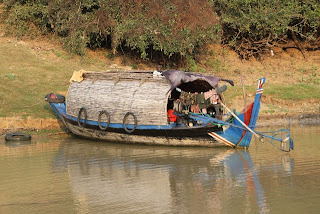The boat trip from Battambang to Siem Reap is, reportedly, the most enchanting boat trip you can make in Cambodia. It also takes anything between 6 and 10 hours, or more – usually the boat is faster in the wet season, when the river, the Stung Sangker, is deeper. It is the dry season, now. Obviously, with so much uncertainty, there is only one boat per day and it leaves at 7 am. Sharp.
(1) Having seen so many sunsets already, let me throw in a sunrise instead. There won’t be many more….
(2) Our boat, the one in the middle, for the next 6 to 10 hours or more. It has a toilet, a coolbox with drinks - pay one dollar now -, and a sun roof, where you burn to death after 9 am.
We took nine hours, not too bad considering the many times we scraped through the mud and almost got stuck, the many times we ploughed through weeds, and the many times we picked up and dropped off passengers in the villages along the way; this is a public ferry, after all, even though more than half of the people on board were foreigners. Those villages are mostly floating, especially the further downstream we got. This river ends in the Tonle Sap lake, which is a reservoir at the upper reaches of the Tonle Sap river, the one that reverses flow in the wet season – resulting in the lake area expanding up to five times its normal size (and up to no less than 70 times its volume!), which somewhat explains the idea of a floating village. Further upstream houses are on stilts, and judging from the height of these, the water level does come up quite a lot indeed.
Anyhow, the nine hours turned out to be very entertaining indeed, initially, around Battambang, through observing village life along the river, people getting on with the day. Mostly fishing communities in what I think are Vietnamese boats, flat boats with a bamboo cover, or sometimes a tarpaulin, which, it seems, contain the entire household. People are often up to their neck in the water, either to reach the fishing gear, or to wash – themselves, or cloths. Why wash, you wonder, the water is so filthy: first of all brown from the mud, but also, downstream from Cambodia’s second-largest town... imagine. Plus all the plastic and other rubbish floating, not a very healthy environment, I should think. Further along the river the population density is less, the settlements look more temporary, perhaps because this is, officially, a nature reserve of sorts, the Prek Toal Bird Sanctuary. How strong this is being enforced is questionable, but we did see a lot more birds – I am not a specialist, but there was quite some variety, in size and colours.
(3) What I think is a “Vietnamese” boat.
(4, 5, 6) Early morning river life, centered on fishing.
(7) Fishing gear drying.
(8) People also keep ducks, in pens on the river side (and pigs, and cows, and water buffalos, but there is a limit to the number of photos I can post, no?)
(9) The bird sanctuary, with some scared white herons, and (10) another colourful bird (not vey sharp, I know).
Closer towards the lake we start seeing the truly floating villages, where almost all structures, including the police station, and, curiously, also a church, are built to go up and down with the water level - or being towed around to another location if that suits the owners better. The landscape becomes flatter, and less overgrown; most of this probably inundates every year between April and October, or so. What a life! Economic driver is still fishing, and fish processing, like cleaning, drying etc., and, boy, it smells, every time we go past the platforms where women are working the catch. By now, some 8 hours after our departure, the trip becomes a bit monotonous - how many floating villages do you need to see before you have seen enough -, and reaching the Tonle Sap lake is therefore something of a relief, for everybody. And, remember from earlier boat trips, we are privileged, we still have our pillows, the other passengers are all sitting on hard wooden benches. Best investment ever, those pillows.
(11) Floating village, and (12, 13) Fish processing activities.
(14) Lunch on the river.
(15) And one of our co-passengers.
(16) More fishing gear, including (17) what is known as the Chinese fishing nets, the ones we know from India (but, curiously, not from China).
(18) Tonle Sap lake.
Finally we reach Chong Kneas, where we disembark for a short tuk-tuk drive to Siem Reap. Ready for Angkor Wat and the surrounding temples, and ready for Cambodia’s preeminent tourist trap.
(Perhaps the “enchanting” nature of this trip is best expressed by the number of pictures accompanying this posting. There are tons more from where this comes from, don’t you worry…)


















Nice pictures Bruno during this long boattrip.
ReplyDeleteCambodja looks very nice to me and I should like to be there but I'm glad we decided not to go to Ttripoli last year!!!!!
Thea